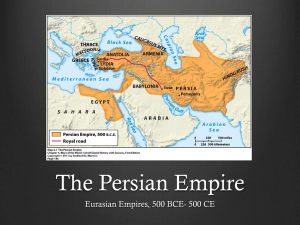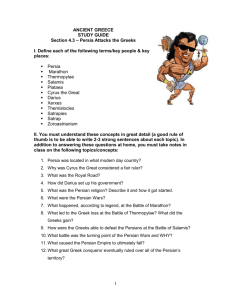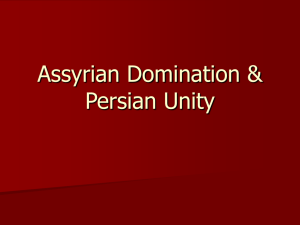Name: ______________________ Date:
advertisement
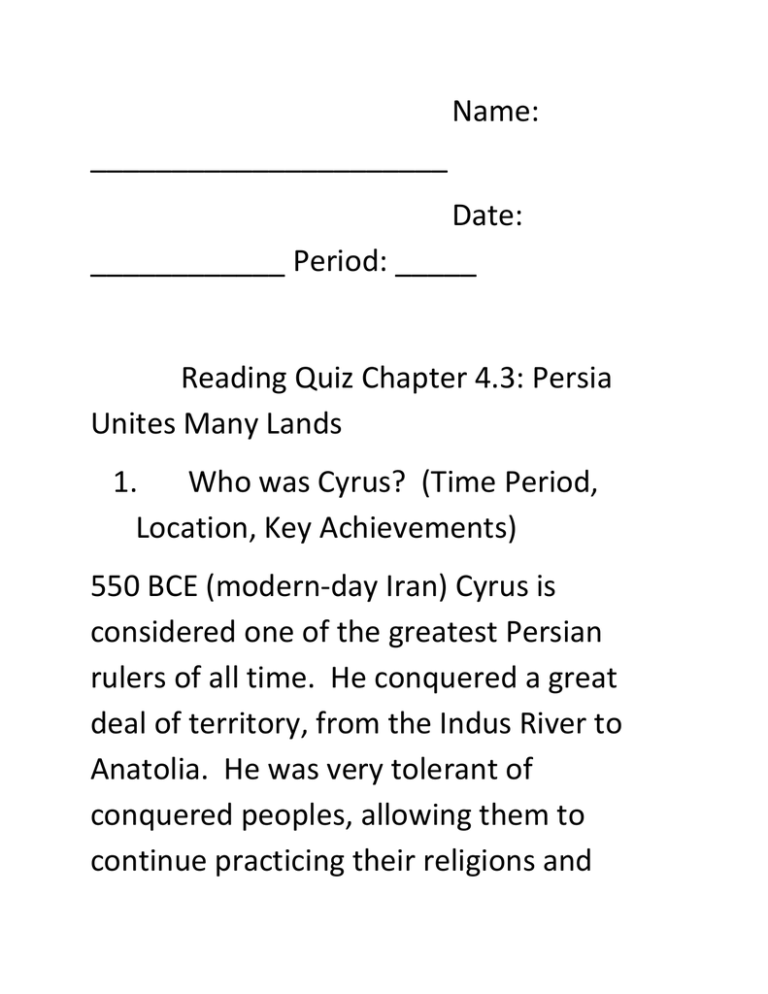
Name: ______________________ Date: ____________ Period: _____ Reading Quiz Chapter 4.3: Persia Unites Many Lands 1. Who was Cyrus? (Time Period, Location, Key Achievements) 550 BCE (modern-day Iran) Cyrus is considered one of the greatest Persian rulers of all time. He conquered a great deal of territory, from the Indus River to Anatolia. He was very tolerant of conquered peoples, allowing them to continue practicing their religions and cultures, as long as they paid tribute to the Persians…also allowed the Jews to return to Jerusalem in 538BCE 2. List and define 3 ways that the Persians effectively administered their expansive Empire. Royal Road- 1,677 miles long Satrapies with Satraps as governors (20 different provinces with own governors) Uniform currency- coins (helped with trade) Tolerant of other cultures/ religions 3. What are some of the key tenets of Zoroastrianism? (founder, holy books, key beliefs) Founder: Zoroaster Struggle between God of Good (Ahura Mazda) and God of Evil (Ahriman) Final Judgment/ paradise/ fiery pit Ethical Dualism Holy Books: Avesta Chapter 4.3 Persia Unites Many Lands I. The Rise of Persia Persians based their empire on tolerance and diplomacy…relied on a strong military Ancient Persia includes modern day Iran A. The Persian Homeland Around 1000BCE- Indo-Europeans first migrated from central European and southern Russia to the mountains and plateaus east of the Fertile Crescent Rich mineral deposits… and thriving trade Medes and others overthrew the Assyrians in 612 BCE…Medes and Persians emerged B. Cyrus the Great Founds an Empire 550BCE- Cyrus began his conquest of several neighboring kingdoms in Iran… Persians eventually extended their rule from the Indus River in the east to Anatolia in the west 2,000 mile empire Soldiers were armed with short bows, which they shot from mountain ponies String of victories- 550 to 539BCE conquered the entire Fertile Crescent Cyrus’s most enduring legacy was his method of governing Very tolerant of conquered peoples…didn’t allow his soldiers to loot and pillage Under Persian rule- subject peoples enjoyed freedom Ex: Cyrus offered prayers to Marduk when he took over Babylon Cyrus also allowed the Jews to return to Jerusalem in 538BCE…many parts of the Torah were recorded during this time Hebrews were very appreciative to Cyrus Cyrus died in battle…tomb “O man, I am Cyrus the son of Cambyses. I established the Persian Empire and was king of Asia. Do not begrudge me my memorial.” II. Persian Rule and Religion Successors to Cyrus had to organize and unify conquered territories by combining Persian control with local self-government A. Cambyses and Darius Cyrus died in 530BCE Son Cambyses: extended the Persian Empire by conquering Egypt…but he scorned Egyptian religion…died after 8 years…widespread rebellions erupted Darius: noble of the ruling dynasty…was one of the king’s bodyguards. Darius seized the throne in 522-521BCEwith help of Ten Thousand Immortals…eventually established an unusually efficient and well-organized administration Extended Persian conquests in the east…into Afghanistan and India…2,500 miles Unable to conquer Greece B. Provinces and Satraps Darius’s greatest genius lay in administration King divided empire into 20 provinces…people still practiced own religion…spoke own language…administrative policy of many groups “nationalities” Darius still ruled with absolute power Governor for each province called a SATRAP o Darius sent out inspectors called “King’s Eyes and Ears” to keep the Satraps in line Excellent road system and use of standard money helped unite the empire o Royal Road ran from Susa in Persia to Sardis in Anatolia (1,677 miles) Manufacturing metal coins (borrowed from the Lydians)…coins of a standard value…promoted trade “Neither snow, nor rain, nor heat, nor gloom of night stays these couriers from the swift completion of their appointed rounds.” –Herodotus in 400’s BC about the Persian messengers on the Royal Road C. Persian Religion Zoroaster: Persian prophet and religious reformer…lived around 600BCE Taught that two spiritual armies fight for possession of a person’s soul. o God of Truth and Light, Ahura Mazda- leads one army o God of Evil and Darkness, Ahriman leads the other At the end of time, all souls would be judged according to which side they had chosen, followers of Ahura Mazda would be lifted into Paradise, followers of Ahriman would suffer forever in a fiery pit. Avesta: collection of books that formed the holy writings of the Zoroastrian religion People’s own choices controlled their fate with a final judgment Concepts of heaven, hell, and final judgment were similar in Zoroastrianism, Judaism, Christianity, and Islam. Faith of Zoroaster spread into India, became the Parsi sect…largest group of Zoroastrians in the world today Also important influence on the development of Manicheanism- religion that competed with early Christianity Cult of Mithra, a Zoroastrian god, spread westward and became popular among the military legions in the Roman Empire D. The Persian Legacy With tolerance and good government, Persians brought political order to Southwest Asia…preserved ideas from earlier civilizations and found new ways to live and rule
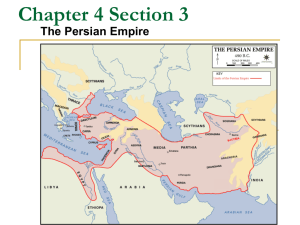
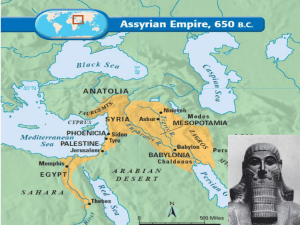
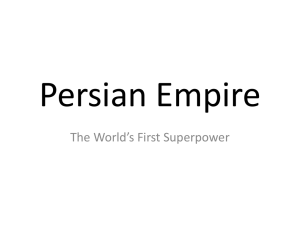
![This [empire] he set up in Persia; and afterwards he... governments of the kind which the Persians call satrapies, assigning... Histories Persia, 5](http://s2.studylib.net/store/data/015577482_1-6df1abb7e9538fea395f91c091a7ccda-300x300.png)
